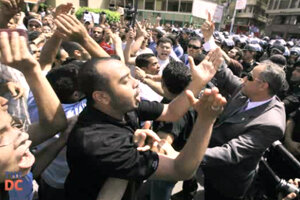With #BlackBrunch, activists try new way of drawing attention to racial issues
On weekends, activists dressed in black are entering restaurant after restaurant, chanting and singing. The idea behind #BlackBrunch is to disrupt business as usual at upscale locations.

Los Angeles
A half century after Huey Newton and Bobby Seale formed the Black Panthers in Oakland, Calif., to carry guns and follow police around to record brutality, a new activism tactic has been launched in the same city to address racial injustice – albeit the weapons are different.
On Sunday, activists dressed in black entered restaurant after restaurant in Oakland. Drawing out megaphones, 36 African-Americans chanted, sang, and filed out.
Known as #BlackBrunch, the idea was born right after a grand jury in Staten Island, N.Y., refused to indict a white police officer in the apparent chokehold death of Eric Garner. In the past month, similar #BlackBrunch scenes have taken place in San Francisco; Berkeley, Calif.; Baltimore; and Boston. And Sunday marked the first #BlackBrunch in Manhattan.
The idea behind #BlackBrunch is to draw attention to racial issues, especially involving police, by disrupting business as usual at upscale locations that are frequented by whites.
“The action by protestors against police violence at Oakland restaurants was yet another example of how the leaders of the protests have gotten both creative in their protests and in picking the places they've targeted for their protests,” says Earl Ofari Hutchinson, a top civil rights activist in Los Angeles who directs the Urban Policy Roundtable, which holds open-mike forums.
“It harked back fifty years to the protests at restaurants in the South against Jim Crow segregation,” adds Mr. Hutchinson, who has written several books on the black experience in America and who made these comments via e-mail.
As part of #BlackBrunch, participants shout in strict unison: “Every 28 hours, a black person in America is killed by the police, a security guard, or a self-anointed vigilante. These are our brothers and sisters, our families. Today and every day, we honor their stolen lives.”
Next, also in unison, are the names of victims: Mr. Garner; Michael Brown of Ferguson, Mo.; Florida teen Trayvon Martin; Oscar Grant, who was killed by police at a transit stop in Oakland; and many more. Each name is punctuated by the Yoruba word “ashe,” which means “so be it” or “amen.” The activists call for patrons to stand in solidarity and then march out, singing.
“The spirit of the Civil Rights Movement is alive in the direct action protests in Ferguson, New York, the Bay Area, and across the nation,” says via e-mail Drew Dellinger – a teacher, poet, and activist who founded Planetize the Movement.
But not everyone thinks #BlackBrunch is the best.
“Frankly I have mixed emotions, having done a lot of protesting in my younger days,” says Greg McConnell of The McConnell Group, a consulting and advocacy firm in Oakland.
When the civil rights activists of the 1960s took their demonstrations to lunch counters, he says, it was to protest not being served by those very lunch counters. But the current protests might drive away clientele, unwittingly causing restaurants to close and thus hurting some of the low-income workers they want to help.
“I’m not sure that alienating patrons of restaurants will be without unintended negative consequences,” Mr. McConnell says.
A veteran of Howard University protests in the ’60s, McConnell says he understands the need of young blacks to do something different – to differentiate themselves from Al Sharpton and Jesse Jackson. He also notes that one motivation for forming #BlackBrunch was for young blacks to not have their message preempted by others. In one recent incident before #BlackBrunch, a white male apparently stripped a black female of her megaphone.
Kevin Walker, a cultural strategist who runs a marketing consultancy called CultureLab in Dallas, thinks the overall effect of the new protests is good.
“Honestly, I think this is a net positive for the movement,” he says, adding that its strength is egalitarian activism, as opposed to the top-down control of the past.
“This is really a collective brought together by Twitter.... There is no need for any messianic leader because they can coalesce and communicate and mobilize through social media.”
But with that plus comes with a potential downside, as was exhibited in the Occupy movement, McConnell says.
“Everything needs a structure to be effective,” he says. “When officials came to the [Occupy] encampments ready to talk to someone about implementing demands, no one could speak for the group. It’s one thing to be for abstract change. But when it comes to details you need real leaders.”

